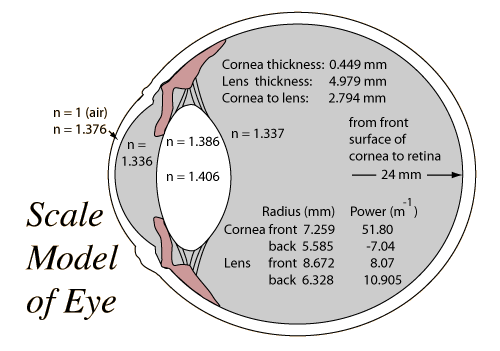
| Design parameters | Accommodation model |
Vision concepts
Image formation concepts
Reference
Hecht, 2nd Ed.
Sec. 5.7
| HyperPhysics***** Light and Vision | R Nave |

|
Index Vision concepts Image formation concepts Reference Hecht, 2nd Ed. Sec. 5.7 | ||
|
Go Back |
|
Index Vision concepts Reference Hecht, 2nd Ed. Sec. 5.7 | ||
|
Go Back |
The term cataract is used to describe the condition of clouding or darkening of this lens. |
Index Vision concepts Reference Hecht, 2nd Ed. Sec. 5.7 | ||
|
Go Back |
|
Index Vision concepts Reference Hecht, 2nd Ed. Sec. 5.7 | ||
|
Go Back |
Vitreous Humor
The index of refraction of both of the interior fluids of the eye are very close to that of water, n= 4/3 = 1.333 . |
Index Vision concepts Reference Hecht, 2nd Ed. Sec. 5.7 | ||
|
Go Back |
|
Index Vision concepts Reference Hecht, 2nd Ed. Sec. 5.7 | ||
|
Go Back |